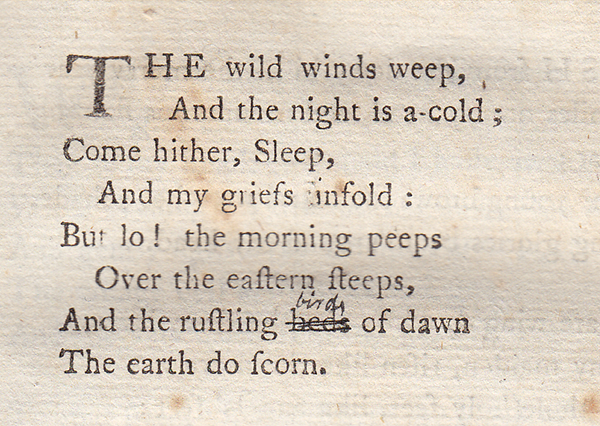
5. Poetical Sketches, p. 15, detail of “Mad Song,” 1st stanza, 3.9 x 5.3 cm. Essick collection. This stanza has been emended in pen and black ink as follows:
Line 4. The left vertical and curving horizontal of the “u” in “unfold” have been rubbed out and a dot written over the right vertical to change the word to “infold,” as in 7 other copies. The ghostly presence of the left vertical is still visible.
Line 7. In “the rustling beds of dawn,” the third word has been deleted with 3 horizontal lines and “birds” written in cursive letters (except for a space between “r” and “d”) above. This emendation appears in 11 other copies. The horizontal lines and lettering above them are almost identical to those in copies E (collection of Alan Parker, London), F (Turnbull Library, Wellington, New Zealand; see the reproduction in William Blake’s Works in Conventional Typography, ed. G. E. Bentley, Jr. [Delmar, New York: Scholars’ Facsimiles & Reprints, 1984]), and Q (Preston Blake Collection, City of Westminster Archives Centre; see the reproduction in Blake, Poetical Sketches, intro. by Robin Hamlyn [London: Tate Publishing, 2007]).
This copy also contains the following pen and black ink emendations:
P. 4, “To Winter,” 3rd line of the 3rd quatrain. The word “in” (“… and in his hand”) deleted with short pen and ink lines, as in 10 other copies.
P. 7, title of “Fair Elenor.” An ink droplet appears over the lower horizontal of the initial “F.” This element of the letter was clearly printed, and thus the oval ink spot would not seem to be an intentional addition to compensate for poor presswork. It is difficult to tell whether this is printing ink or ink from a pen; in either case, this feature is probably accidental.
P. 7, “Fair Elenor,” 2nd line of the 2nd quatrain. The “s” in “cheeks” has been rubbed out. This letter has been deleted, either by rubbing out or lining through in black ink, in 5 other copies.
P. 9, “Fair Elenor,” 1st line of the 15th quatrain. There appears to be a short horizontal line crossing the upper vertical of the “h” of “the” in “the bloody cloth unfolds.” This line does not have any verbal or typographic purpose and may not be intentional.
P. 9, “Fair Elenor,” 1st line of the 16th quatrain. The words “I am” have been rubbed out and “behold” in uncial letters written in their place, as in 8 other copies. The pen and ink letters are remarkably similar to those in copies S (Huntington Library) and Q.
P. 15, “Mad Song,” final line. A short vertical line appears between the 2nd and 3rd letters of “pain.” The purpose of this line is unclear; it may have been made accidently by Blake when he was writing the 2 annotations higher on this page.
P. 29. In the stage direction for scene 1 of “King Edward the Third,” “before / it.” is deleted with smudged horizontal lines. In copy S, the only other copy recorded as containing this deletion, the lines are less smudged.
I am confident that all these emendations in pen and black ink were made by Blake. The same intentional annotations—and no others—also appear in copy S, which John Flaxman left with William Long for delivery to William Hayley, as Flaxman states in a letter to Hayley of 26 April 1784 (BR[2] 31). I suspect that copy S and the newly discovered copy were annotated by Blake at about the same time. For a record of Blake’s handwritten additions in previously recorded copies, see William Blake’s Writings, ed. G. E. Bentley, Jr. (Oxford: Clarendon P, 1978) 2: 750-95.
